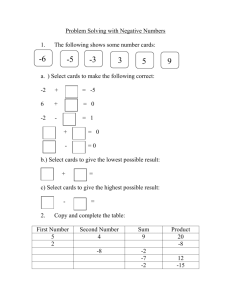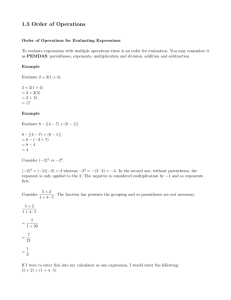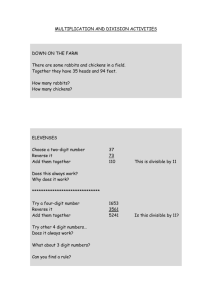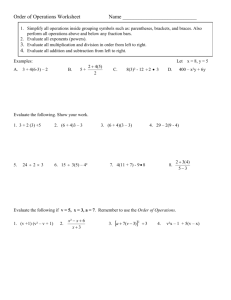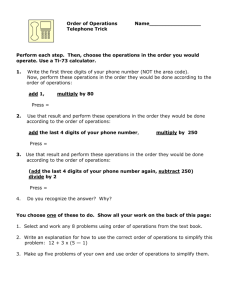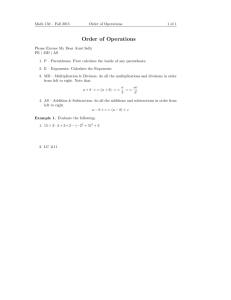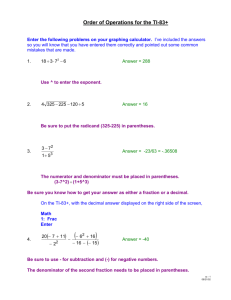22 1–6 Combined Operations
advertisement
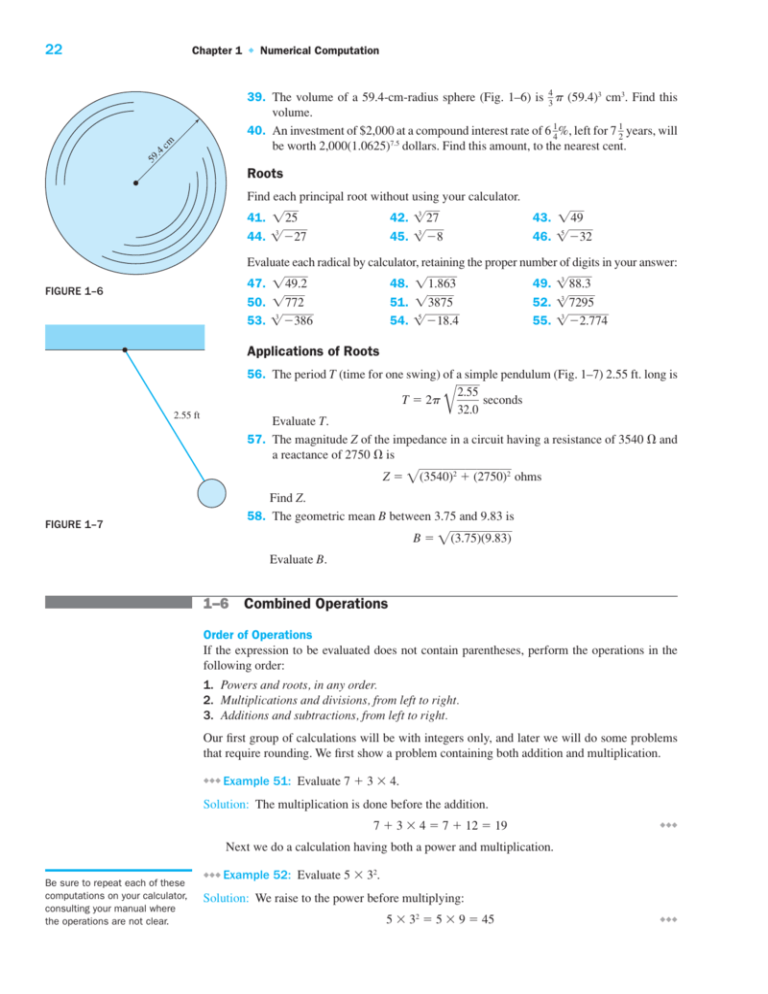
22 Chapter 1 ◆ Numerical Computation 59 .4 cm 39. The volume of a 59.4-cm-radius sphere (Fig. 1–6) is 43 (59.4)3 cm3. Find this volume. 40. An investment of $2,000 at a compound interest rate of 6 14 %, left for 7 12 years, will be worth 2,000(1.0625)7.5 dollars. Find this amount, to the nearest cent. Roots Find each principal root without using your calculator. 41. 兹 25 3 44. 兹 27 43. 兹 49 5 46. 兹 32 3 42. 兹 27 3 45. 兹 8 Evaluate each radical by calculator, retaining the proper number of digits in your answer: 48. 兹 1.863 51. 兹 3875 5 54. 兹 18.4 47. 兹 49.2 50. 兹 772 3 53. 兹 386 FIGURE 1–6 3 49. 兹 88.3 3 52. 兹 7295 3 55. 兹 2.774 Applications of Roots 56. The period T (time for one swing) of a simple pendulum (Fig. 1–7) 2.55 ft. long is 2.55 T 2p seconds 32.0 Evaluate T. 57. The magnitude Z of the impedance in a circuit having a resistance of 3540 and a reactance of 2750 is 兹 2.55 ft Z 兹(3540)2 (2750)2 ohms Find Z. 58. The geometric mean B between 3.75 and 9.83 is FIGURE 1–7 B 兹 (3.75)(9.83) Evaluate B. 1–6 Combined Operations Order of Operations If the expression to be evaluated does not contain parentheses, perform the operations in the following order: 1. Powers and roots, in any order. 2. Multiplications and divisions, from left to right. 3. Additions and subtractions, from left to right. Our first group of calculations will be with integers only, and later we will do some problems that require rounding. We first show a problem containing both addition and multiplication. ◆◆◆ Example 51: Evaluate 7 3 4. Solution: The multiplication is done before the addition. 7 3 4 7 12 19 ◆◆◆ Next we do a calculation having both a power and multiplication. Be sure to repeat each of these computations on your calculator, consulting your manual where the operations are not clear. ◆◆◆ Example 52: Evaluate 5 32. Solution: We raise to the power before multiplying: 5 32 5 9 45 ◆◆◆ Section 1–6 ◆ 23 Combined Operations Parentheses When an expression contains parentheses, evaluate first the expression within the parentheses and then the entire expression. ◆◆◆ Example 53: Evaluate (7 3) 4. Solution: (7 3) 4 10 4 40 ◆◆◆ If the sum or difference of more than one number is to be raised to a power, those numbers must be enclosed in parentheses. ◆◆◆ Example 54: Evaluate (5 2)2. Solution: We combine the numbers inside the parentheses before squaring. (5 2)2 72 49 ◆◆◆ ◆◆◆ Example 55: Evaluate (2 6)(7 9). Solution: Evaluate the two quantities in parentheses before multiplying. (2 6)(7 9) 8 16 128 ◆◆◆ ◆◆◆ 84 Example 56: Evaluate . 93 Solution: Here the fraction line acts like parentheses, grouping the 8 and 4, as well as the 9 and 3. Written on a single line, this problem would be (8 4) (9 3) or 12 6 2 ◆◆◆ Combined Operations with Approximate Numbers Combined operations with approximate numbers are done the same way. However, we must round our answer properly using the rules given earlier in this chapter. ◆◆◆ Example 57: Evaluate the expression 3 p 118.8 4.23 q 兹 136 Solution: By calculator, we get a result of 1174.153 047. But how many digits should we keep? In the numerator, we added a number with one decimal place to another with two decimal places, so we are allowed to keep just one. Thus, the numerator, after addition, is good to one decimal place, or, in this case, four significant digits. The denominator, however, has just three ◆◆◆ significant digits, so we round our answer to three significant digits, getting 1170. 33.74 ft ◆◆◆ Example 58: A rectangular courtyard (Fig. 1–8) having sides of 21.8 ft. and 33.74 ft. has a diagonal measurement x given by the expression x 兹 (21.8)2 (33.74)2 x 21.8 ft Evaluate the expression to find x. Solution: By calculator we get a result of 40.169 984. We round our answer to three ◆◆◆ significant digits because 21.8 has only three, and we get x 40.2 ft. FIGURE 1–8 A rectangular courtyard. 24 Chapter 1 ◆ Numerical Computation Exercise 6 ◆ Combined Operations Combined Operations with Exact Numbers Perform each computation by calculator. 1. (37)(28) (36)(64) 2. (22)(53) (586)(4) (47)(59) 3. (63 36)(37 97) 4. (89 74 95)(87 49) 219 194 5. 73 97 228 78 364 6. 38 91 26 647 688 7. 337 108 809 463 1858 8. 958 364 508 9. (5 6)2 10. (422 113 533)4 11. (423 420)3 2 p 853 229 q 12. 874 562 13. p 141 q3 47 14. 兹 434 466 15. 兹 (8)(72) 3 16. 兹 657 553 1085 4 17. 兹 (27)(768) 2404 18. 601 兹 1136 19. 兹 71 4 20. 兹 961 兹121 3 4 625 兹961 兹 216 21. 兹 4 22. 兹 256 兹49 Combined Operations with Approximate Numbers Perform the computations, keeping the proper number of digits in your answer. 23. (7.37)(3.28) (8.36)(2.64) 24. (522)(9.53) (586)(4.70) (847)(7.59) 25. (63.5 83.6)(8.37 1.72) 26. (8.93 3.74 9.05)(68.70 64.90) 583 946 27. 473 907 6.73 5.97 8.63 28. 8.38 8.06 1.91 ◆ Section 1–7 25 Scientific and Engineering Notation 6.47 8.604 29. 3.37 90.8 809 463 744 30. 758 964 508 31. (5.37 2.36)2 32. (4.25 4.36 5.24)4 33. (6.423 1.05)2 34. 35. p 8.90 4.75 q 2 38. 兹 (28.1)(5.94) 5 39. 兹 (9.06)(4.86)(7.93) 40. 兹 42. 兹 9.74 兹 12.5 3 4 43. 兹 528 兹94.2 兹 284 1–7 兹 653 601 4.50 7.81 2.5 q 4 45.3 8.34 8.74 5.62 36. 兹 4.34 4.66 3 37. 兹 657 553 842 41. p 3 44. 兹 653 兹 55.3 Scientific and Engineering Notation Evaluating Powers of 10 We did some work with powers in Sec. 1–5. We saw, for example, that 23 meant 23 2·2·2 8 Here, the power 3 tells how many 2’s are to be multiplied to give the product. For powers of 10, the power tells how many 10’s are to be multiplied to give the product. ◆◆◆ Example 59: (a) 102 10 10 100 (b) 103 10 10 10 1000 ◆◆◆ Negative powers, as before, are calculated by means of Eq. 35, xa 1/xa. ◆◆◆ Example 60: 1 1 (a) 102 0.01 2 100 10 1 1 (b) 105 0.000 01 5 100 000 10 ◆◆◆ Some powers of 10 are summarized in the following table: Positive Powers 1 000 000 100 000 10 000 1000 100 10 1 Table 1–1 106 105 104 103 102 101 100 Negative Powers 1/10 101 0.1 1/102 102 0.01 1/103 103 0.001 1/104 104 0.0001 0.000 01 1/105 105 0.000 001 1/106 106
